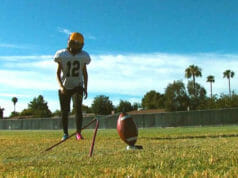I have been playing video games my entire life. I can’t even begin to tell you how many times I’ve saved Princess Peach from the clutches of Bowser, freed the land of Hyrule from Ganon, and liberated Raccoon City from a massive zombie outbreak.
Growing up, however, I was told that these games were largely a waste of time and that I wouldn’t learn anything from them. While it remains to be seen how I’ll do in a zombie outbreak, (though chances are ‘pretty good’) over the past decade there has been a string of evidence that video games can be useful to teaching tool.
Nothing exemplifies that “video games are knowledge” belief than the Madden football series. Madden originally debuted in 1988, then under the name John Madden Football, and has been an annual staple in sports video games since 1990.
In this article, we’re going to explore why Madden is indeed the football simulator it claims to be – and why playing Madden can make you a better football player, fan, or coach.
Tyler Lockett is All In On Madden…And He’s Not the First
Tyler Lockett is a wide receiver on the Seattle Seahawks. Lockett, who played for Kansas State in college, was the 69th pick in the third round of the 2015 NFL Draft. Though still only a few years into his pro career, Lockett has earned accolades including spot in the 2016 Pro Bowl.
Most interesting about Tyler Lockett, however, is how Madden taught him to be a better football player.
Lockett noted that, even though it sounds crazy, this is something that gives you a better IQ of the game.
Though it’s not as crazy as it sounds, because Lockett is hardly the first.
Like Meeting Mario in Real Life
Bjoern Werner was drafted out of Florida State as the 24th overall pick in 2013. Originally from Berlin, Werner played his way through high school and college to end up on the Indianapolis Colts, but his greatest teacher of the game was whatever console Werner was playing Madden on. The way Werner described this was as if some of us got to meet Mario in real life.
“I knew every NFL star probably when I was 12, 13 or 14. I learned every team, every player in the game and I always created my little all-star games, all-star teams,” Werner said in an interview published on NFL.com. “I was just telling a few people when I was 12, 13, 14, I played with Robert Mathis and Dwight Freeney. They were like the dynamic duo for years. Now I’m going to play with Robert Mathis. He’s going to be my veteran. I can ask questions, I can look up to him. This is just so amazing and so unbelievable.”
Other players were following suit. 2014 rookie Teddy Bridgewater said that after his mini camp he didn’t have a real team he could field and practice with yet, so instead he leveraged a digital one to learn the Minnesota Vikings – whom he had been drafted by – to be more prepared for the season.
What makes Madden so special to athletes? Why is this game such a great teacher of an otherwise incredibly complex sport. To understand that, we need to understand what Madden does.
A Simulation (and Gamification) of Football
Understanding the game of football is a lot like understanding how a car works. For some people, the most they know about how their car works is they put their key in, magic happens, and as long as they feed the car gas everything should be fine. For others, they can name exactly what gears are doing what to make everything work in harmony. Still others might be passionate with the history of cars, and how they’ve developed over time. Other drivers can be much more technical and know how different automobiles respond in different situations.
Football is similar in these ways, but taking the time to learn a new sport or become better informed can take a lot of hours – which, despite sports entertaining nature, isn’t always fun or welcoming. Let’s face it, we’re talking about a sport with expansive rosters, detailed and specific plays for both offense and defense, different styles of play by each team and coach, and different players with different skillsets. That’s before you factor in history, injuries, and even a home or away environment!
Madden does a few things to make this daunting library of details much more approachable.
You’re also able to see the play displayed on the field, showing you exact routes your offense can run or coverage your defense should be doing, all based on the play you called. As you get more acclimated in the game you can choose your own plays (taking your own risks) or even learn how audibles and the like work with in-game menus. These are entirely optional and a player can be just as successful playing the game without them, but eventually players will feel more comfortable enough to advance into these complex territories.
And that’s the high-level thing Madden does – it takes otherwise incredibly complex aspects of the game, simplifies them, and then gives you the option to explore them at your own pace. The game holds your hand as much as it needs to, and it goes at the pace of the player.
This is good not only for learning the game, but learning teams and behaviors as well. Madden has been striving for authenticity since 1988, going so far as to use playbooks from teams in their early days, and more recently takes the time to speak with experts, players, and coaches to continue refining their knowledge of the game and deciding what to put into the game – as well as what to leave out.
New York Times writer Jay Caspian Kang noted in his own experiences learning about football from Madden that the game gives you a sense of omnipotence and omnipresence over the field. You can see visual outlines of every play, assess every piece of the game, as it plays out in real time. Rather than waiting for explanations from what happened from the commentators during a live game, the game shows you exactly what’s happening – and puts you in the driver’s seat to see what works and what doesn’t. You have control over every play, and that’s a powerful tool for learning.
those who played Madden had a 60% higher football IQ than those who didn’t
Kotaku has observed that Madden does indeed work. In a 2009 article the gaming website noted a study by the University of Oregon that discovered those who played Madden had a 60% higher football IQ than those who didn’t. Everything from history to technical decisions and plays were elevated for Madden players. Madden as a simulation tool is an effective educator for fans and players alike.
Madden is possibly one of the best and worst examples of gamification at work today. For those unfamiliar, gamification is a relatively new concept (gaining notice only around 2010) which focuses on how using game elements in non-game settings can help someone learn faster, better remember and apply concepts, make things easier, and improve engagement. This concept has been introduced in many different areas from employee training and work, to marketing and technology.
While Madden is most certainly a game, learning the intricacies of the game can feel more like studying for the SATs at times. Madden is able to take those otherwise daunting, difficult, and dry concepts, and roll them into an experience that is fun, engaging, and educational. The game may exist strictly as a game, but the elements at work are examples of gamification – and can act as proof of it’s effectiveness.
Smarter Fans
In order to really understand just how much of an impact Madden has on the average fan, I asked fans of football and Madden alike how this game helped them become more knowledgable at the game.
I asked some people who are fans of the game what Madden did to educate them further about the game. I got some great specifics. Examples include:
- A fan who noted that they learned more about defensive coverages when watching games. The fan also noted that Madden games helped keep them informed about injuries and trades, as the later games feature live roster updates based on what happened that week on the field.
- One fan, located in the UK, was exposed to the game when two teams played a game in London in 2015. Although the fan only had a basic understanding of the game at the time, Madden was able to help them learn specific plays and even recognize defensive coverages when they watches the games on TV now.
- One fan who played football actually used Madden to become much more educated as a player. Specifically, the player noted situational awareness (such as pushing a runner out of bounds to end the half, rather than going for a full-force tackle and potentially missing the runner and giving up a touchdown) as a key benefit from playing Madden. It also taught him where his support was on the field, so he could be a better teammate as well.
For many fans of football, this game is a great teacher, but what about those who have no knowledge of football?
Football 101
I asked a friend of mine who’s never cared for football or bothered to learn the rules to play a game on (very) easy mode and see what he could pick up. After that, I asked him to explain what he knew about football now. Sure enough, he was as qualified to talk about the game as John Madden himself! Well, not really – but he was able to break down some of the rules – four downs for every ten yards, you can pass or run the ball, how much a touchdown was worth, how much a field goal was worth, how you normally either “kick it for three” if you’re on your last down rather than try to pass it, but sometimes you also “punt it as far away as possible” if you’re too far for that. Again, these were basic things, but it showed just how much Madden can be used as a teacher for the experienced and inexperienced alike.
Madden is one of, if not the most, iconic sports franchises in the history of video games. And it may also be one of the best teachers of football that’s available to anyone with $60 and a console (or far cheaper if you want to find a previous year’s version). While it’s not a perfect, 1:1 replication of the game, it is arguably one of the most accessible, detailed, and fun ways to learn.
Just ask Tyler Lockett.








